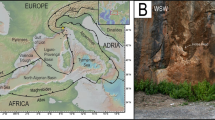Abstract
Investigators of deformation features on the surface of Mars have generally concluded that fault zones with major horizontal displacements do not occur or have not been preserved1–5. Here we present evidence from high-resolution Viking imagery for an array of structures along the Gordii Dorsum escarpment which suggest that it is a left-lateral strike-slip fault zone of lithospheric proportion. The escarpment is one of an array of subparallel ridges6,7 preserved in an equatorial region to the west of Tharsis Montes. The region is of transitional character between the youthful ('Amazonian' age) cover of the Amazonia Planitia to the north and older ('Noachian' age) intensely cratered surfaces of the Highlands to the south. Relations between these ridges and the Gordii Dorsum suggest that the ridges are exhumed ancient fault zones. These features imply that Mars, like the Earth today, may have had in its early stages a more dynamic tectonic style of planetary evolution.
Similar content being viewed by others
References
Basaltic Volcanism Study Project Basaltic Volcanism of the Terrestrial Planets (Pergamon, New York, 1981).
Scott, D. H. & Carr, M. H. U.S. geol. Surv. 1-1083 (USGS, Denver, 1978).
Wise, D. U., Golombek, M. P. & McGill, G. E. Icarus 38, 456–472 (1979).
Phillips, R. J. & Ivins, E. R. Phys. Earth planet. Inter. 19, 107–148 (1979).
Golombek, M. J. geophys. Res. 90, 3065–3074 (1985).
U.S. geol. Surv. Map 1-1535, 1:15M Shaded Relief (USGS, Denver, 1985).
U.S. geol. Surv. Map 1-1333 1:2M (USGS, Denver, 1981).
Tchalenko, J. S. Geol. Soc. Am. Bull. 81, 1625–1640 (1970).
Wilcox, R. E., Harding, T. P. & Seely, D. R. Bull. Am. Ass. Petrol. Geol. 57, 74–96 (1973).
Scott, D. H. & Tanaka, K. L. J. geophys. Res. 87, 1179–1190 (1982).
Schaber, G. E., Horstman, K. C., Dial, A. L. Jr, Scott, D. H. & Tanaka, K. C. U.S. geol. Surv. Map 1-1280 (USGS, Denver, 1982).
Morris, E. C. & Dwornik, S. E. U.S. geol. Surv. Map 1-1049 (USGS, Denver, 1978).
McCauley, J. F. et al. Icarus 17, 289–327 (1978).
Carr, M. H. U.S. geol. Surv. Map 1-893 (USGS, Denver, 1975).
Harding, T. P. & Lowell, J. D. Bull. Am. Ass. Petrol. Geol. 63, 1016–1058 (1979).
Harding, T. P. Bull. Am. Ass. Petrol. Geol. 69, 582–600 (1985).
Author information
Authors and Affiliations
Rights and permissions
About this article
Cite this article
Forsythe, R., Zimbelman, J. Is the Gordii Dorsum escarpment on Mars an exhumed transcurrent fault?. Nature 336, 143–146 (1988). https://doi.org/10.1038/336143a0
Received:
Accepted:
Issue Date:
DOI: https://doi.org/10.1038/336143a0
- Springer Nature Limited





